典范英语拼读教程3 Lesson5
- 格式:ppt
- 大小:7.99 MB
- 文档页数:21
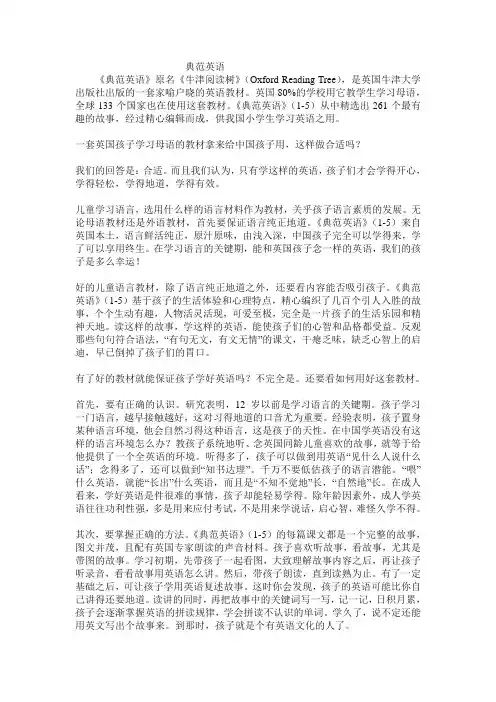
典范英语《典范英语》原名《牛津阅读树》(Oxford Reading Tree),是英国牛津大学出版社出版的一套家喻户晓的英语教材。
英国80%的学校用它教学生学习母语,全球133个国家也在使用这套教材。
《典范英语》(1-5)从中精选出261个最有趣的故事,经过精心编辑而成,供我国小学生学习英语之用。
一套英国孩子学习母语的教材拿来给中国孩子用,这样做合适吗?我们的回答是:合适。
而且我们认为,只有学这样的英语,孩子们才会学得开心,学得轻松,学得地道,学得有效。
儿童学习语言,选用什么样的语言材料作为教材,关乎孩子语言素质的发展。
无论母语教材还是外语教材,首先要保证语言纯正地道。
《典范英语》(1-5)来自英国本土,语言鲜活纯正,原汁原味,由浅入深,中国孩子完全可以学得来,学了可以享用终生。
在学习语言的关键期,能和英国孩子念一样的英语,我们的孩子是多么幸运!好的儿童语言教材,除了语言纯正地道之外,还要看内容能否吸引孩子。
《典范英语》(1-5)基于孩子的生活体验和心理特点,精心编织了几百个引人入胜的故事,个个生动有趣,人物活灵活现,可爱至极,完全是一片孩子的生活乐园和精神天地。
读这样的故事,学这样的英语,能使孩子们的心智和品格都受益。
反观那些句句符合语法,“有句无文,有文无情”的课文,干瘪乏味,缺乏心智上的启迪,早已倒掉了孩子们的胃口。
有了好的教材就能保证孩子学好英语吗?不完全是。
还要看如何用好这套教材。
首先,要有正确的认识。
研究表明,12岁以前是学习语言的关键期。
孩子学习一门语言,越早接触越好,这对习得地道的口音尤为重要。
经验表明,孩子置身某种语言环境,他会自然习得这种语言,这是孩子的天性。
在中国学英语没有这样的语言环境怎么办?教孩子系统地听、念英国同龄儿童喜欢的故事,就等于给他提供了一个全英语的环境。
听得多了,孩子可以做到用英语“见什么人说什么话”;念得多了,还可以做到“知书达理”。
千万不要低估孩子的语言潜能。
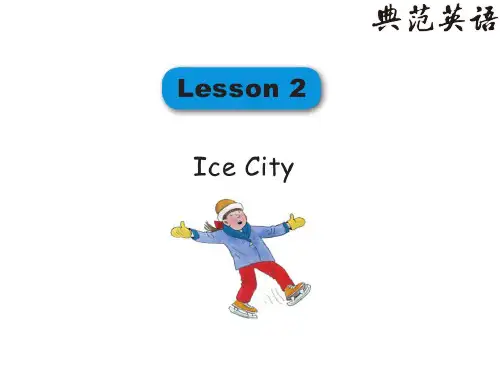
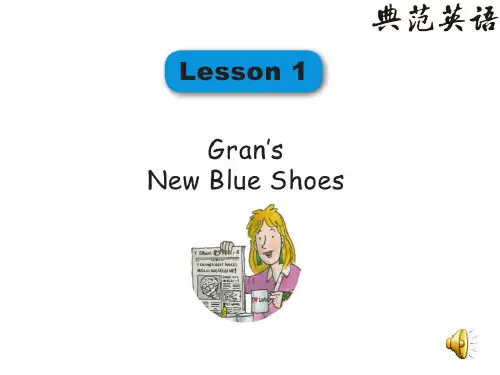
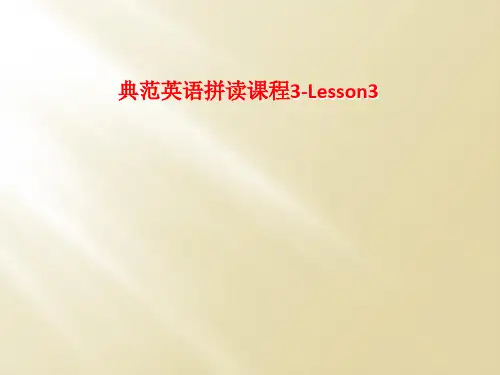

Lesson 1 The Dragon DanceMrs. May made a dragon. The children helped her. Mrs. May painted the head. The children painted the body. The dragon had a long body. The children liked the dragon. They wanted to do the dragon dance. The children got inside the body. Mrs. May helped them. “It’s made of paper” said Mrs. May, “Be careful.” Aneena was inside the head. “Be careful,” said Mrs. May, “don’t tear the paper.” The mums and dads came. The children did the dragon dance. “What a good dragon!” said everyone. Oh, no, the dragon dance went wrong. The dragon tore in half. The children were upset. “Never mind” said Mrs. May, “it was only made of paper.”Aneena’s mom had an idea. She told the moms and dads. “What a good idea!”they said. The mums and dads made a dragon. They made a long body. They made a big head. The dragon looked wonderful. The children were pleased. They wanted to do the dragon dance. The children went into town. They did the dragon dance. “Come to the School Fair,” said the children. “What a lot of people!” said Mrs. May, “thanks to the dragon.”Lesson 2 The Flying ElephantMom went shopping. She took the children. The children looked up. There was an elephant on the roof. The elephant looked funny. The elephant was fat. The children laughed. “Look at that fat elephant,”they said. “An elephant?” said mom “don’t be silly.”There was a storm. The wind blew. It rained and rained. It was a bad storm. The wind was strong. It blew the elephant away.The children went to school. The elephant was in the playground. The children laughed. The children told Mrs. May. “Look at that fat elephant,” they said. “An elephant?” said Mrs. May, “don’t be silly.” The children liked the fat elephant. They wanted it to stay. “Sorry,” said the man. “We want it back.”Lesson 3 Everyone Got WetDad looked at the water butt. The water butt was leaking. Mum looked at the hose. The hose was leaking. “Oh bother!” said Mum. Dad mended the water butt. He put a patch on it. “What a tricky job!” he said. The water butt burst. All the water came out. Dad go wet. Mum mended the hose. She put a patch on it. “What a tricky job!” she said. Mum put the hose on the tap. The top of the tap came off. Mum got very wet. Dad got a new water butt. He put it on the bricks. He got the hose. He filled up the water butt. The water butt fell over. The water poured out. Dad got wet again. Mum got a new hose. She joined it to the old hose. She wanted to water the roses. Kipper wanted to help. He turned the tap on. Mum got wet again. “Oh no!” said Mum. The children got the paddling pool. They put it on the grass. Dad got the new hose. Biff turned on the tap. No water came out of the hose. “Funny!”said Dad. He looked down the hose. Oh no! The children got wet.Lesson 4 Wet PaintDad was painting the back door. The children were outside. Floppy wanted to come in. He jumped up. He put his paws on the paint. Dad painted the door again. Biff kicked a ball. The ball hit the door. Dad painted the door again. Kipper pushed the door. He got paint on his hands. Dad was fed up. He painted the door again. “What a job!”said Dad. Biff and Chip had a pillow fight. The pillow split open. “Oh no!” said Biff. The wind blew. It blew the feathers. “Oh no!” said Chip. “Wet paint!”There was no wet paint. The door had gone. Dad had put up an old door. The back door was inside. “It’s safe here,” said Dad.Lesson 5 The ScarfAnneena liked knitting. She made a scarf. Annena’s mum helped her. The scarf was long and warm. “It’s a good scarf,” said Anneena. Biff and Chip came to play. It was a cold day. Anneena put on her scarf. “What a cold day!” she said. Biff looked at Anneena’s scarf. “What a long scarf!” shesaid. “I made it,”said Anneena. “I couldn’t stop knitting.” The children went to the park. They went to the pond. The pond was frozen. They pulled Anneena’s scarf. “Stop it!” shouted Anneena. “Stop it!”shouted Anneena’s mum. A boy went on the ice. The ice was dangerous. “Get off,”shouted Anneena’s mum. “The ice is not safe.” Anneena’s mum couldn’t get the boy. She couldn’t go on the ice. Everyone was frightened. “Help!” shouted the boy. Anneena had a good idea. She took off her scarf. “Make a rope,”she said. Anneena’s mum made a rope. She made it out of scarves and coats. She threw it to the boy. Everyone pulled the rope. They pulled the boy out of the pond. The boy was safe. “Hooray!”shouted Anneena. “I’m sorry!”said the boy. “Thank you.”“Ice is dangerous,”said Anneena. Anneena looked at her scarf. “I’m glad I made it long,” she said.Lesson 6 SwapNadim found a bat. It was broken. Nadim mended the bat. His dad helped. The bat looked good. Chip had a robot. The robot was broken. Chip liked Nadim’s bat. He swapped the robot for the bat. Nadim mended the robot. The robot looked good. Biff had a skateboard. It had no wheels. Biff swapped it for the robot. Nadim mended the skateboard. He put on new wheels. “It’s a good skateboard now,”he said. Wilma had a bike. The bike was broken. She swapped it for the skateboard. Nadim mended the bike. He painted it black. The bike looked good. “Not bad,” said Nadim.Lesson 7 An important CaseThe children were outside. They were playing football. Wilf kicked the ball. It landed in a bush. “Sorry,”said Wilf. Wild couldn’t get the ball. “I can get it,”said Kipper. Kipper found a case. “Look at this,”he said. “I found it in the bush.” Dad looked at the case. He couldn’t open it. Wilf looked at the case. “What can be in it?”he asked. “It looks important.”“What is in it?” asked Wilma. “I don’t know,” said Chip, “but it looks very important.”“What is in the case?” asked Kipper. “I don’t know,” said Biff, “but it looks very, very important.”“What is in this case?” asked dad. “We don’t know,” said the police officer, “but it is very important.” A man came in a big car. “Who is he?” asked Kipper. “I don’t know,” said dad, “but he looks important.” The man took the case. “It’s my case,” he said. “Thank you. It was stolen. It is very important.” The man got in the car. “Excuse me,” said Wilma. “What is in the case?”“Ah!” said the man. “My sandwiches.”。
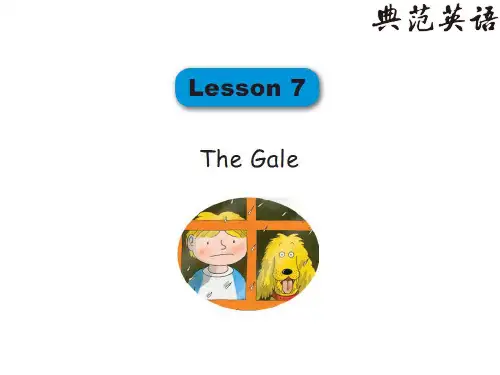
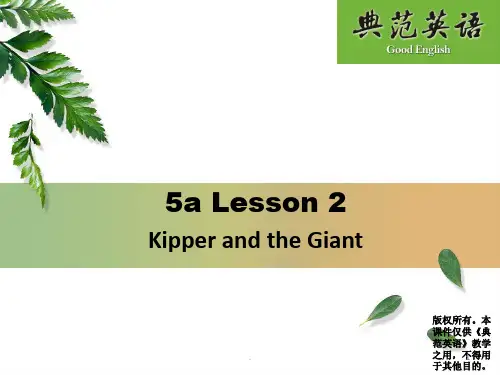
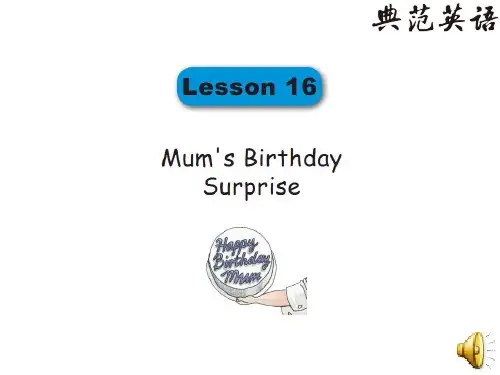
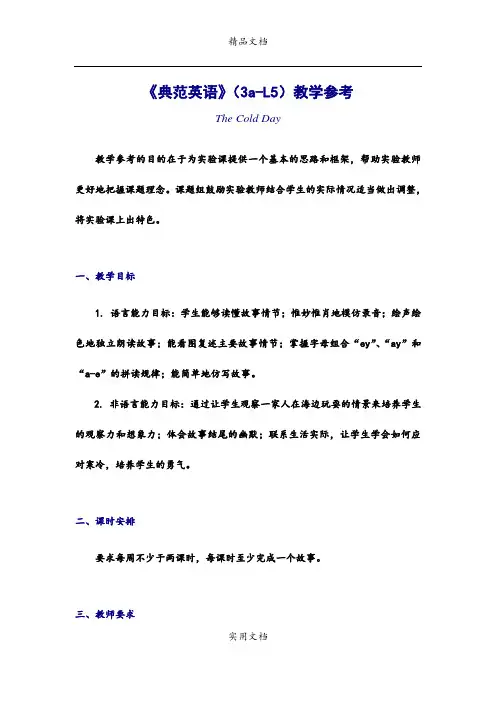
《典范英语》(3a-L5)教学参考The Cold Day教学参考的目的在于为实验课提供一个基本的思路和框架,帮助实验教师更好地把握课题理念。
课题组鼓励实验教师结合学生的实际情况适当做出调整,将实验课上出特色。
一、教学目标1. 语言能力目标:学生能够读懂故事情节;惟妙惟肖地模仿录音;绘声绘色地独立朗读故事;能看图复述主要故事情节;掌握字母组合“ey”、“ay”和“a-e”的拼读规律;能简单地仿写故事。
2. 非语言能力目标:通过让学生观察一家人在海边玩耍的情景来培养学生的观察力和想象力;体会故事结尾的幽默;联系生活实际,让学生学会如何应对寒冷,培养学生的勇气。
二、课时安排要求每周不少于两课时,每课时至少完成一个故事。
三、教师要求1. 教师课前须熟读故事,了解故事内容。
2. 对于较难的单词,教师可板书,并配合动作和表情帮助学生理解。
3. 全英文授课。
四、教学用具多媒体设备、课件(课题组提供)、故事图片(第2、3、4、6、7、9幅图)、单词或短语卡(play in the waves, jog, play cricket, dig in the sand)五、课堂教学基本步骤1. 导入(Lead-in):谈论天气,引入故事情景教师引导学生谈论天气,以及在天冷的时候喜欢做什么,从而引入故事情境。
What’s the weather like? (分别展示热天和冷天两幅图)What do you like to do on hot days/on cold days? (请学生自由回答)Do you like to play in the sea on hot days? (展示夏季海滩游玩的图片)Do you like to go to the seaside on cold days?之后,展示故事第一幅图片,自然过渡到讲故事环节:Look! The children were in the sea.(展示故事第1幅图)Was it a cold day or a hot day? What would happen in the story? Let’s have a look.2. 看图讲故事(Storytelling):理解故事情节,观察一家人在海边玩耍的情景教师利用课件逐幅播放故事图片,并用丰富的表情、生动的英文和适当的肢体语言给学生绘声绘色地讲故事,让学生观察天气以及一家人在海边做了些什么。
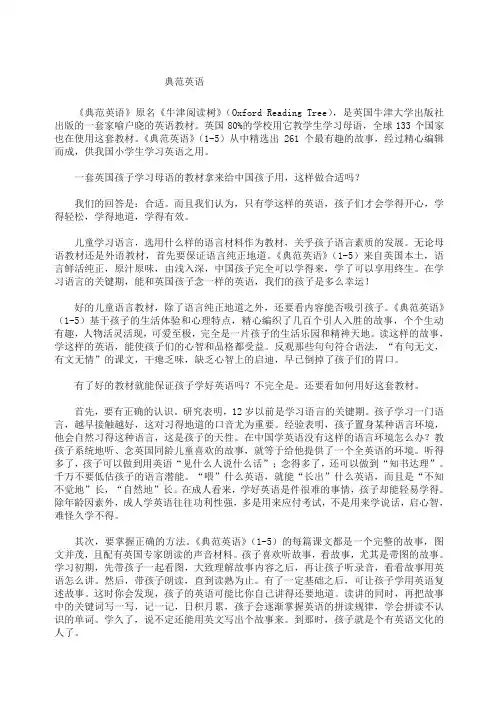
典范英语《典范英语》原名《牛津阅读树》(Oxford Reading Tree),是英国牛津大学出版社出版的一套家喻户晓的英语教材。
英国80%的学校用它教学生学习母语,全球133个国家也在使用这套教材。
《典范英语》(1-5)从中精选出261个最有趣的故事,经过精心编辑而成,供我国小学生学习英语之用。
一套英国孩子学习母语的教材拿来给中国孩子用,这样做合适吗?我们的回答是:合适。
而且我们认为,只有学这样的英语,孩子们才会学得开心,学得轻松,学得地道,学得有效。
儿童学习语言,选用什么样的语言材料作为教材,关乎孩子语言素质的发展。
无论母语教材还是外语教材,首先要保证语言纯正地道。
《典范英语》(1-5)来自英国本土,语言鲜活纯正,原汁原味,由浅入深,中国孩子完全可以学得来,学了可以享用终生。
在学习语言的关键期,能和英国孩子念一样的英语,我们的孩子是多么幸运!好的儿童语言教材,除了语言纯正地道之外,还要看内容能否吸引孩子。
《典范英语》(1-5)基于孩子的生活体验和心理特点,精心编织了几百个引人入胜的故事,个个生动有趣,人物活灵活现,可爱至极,完全是一片孩子的生活乐园和精神天地。
读这样的故事,学这样的英语,能使孩子们的心智和品格都受益。
反观那些句句符合语法,“有句无文,有文无情”的课文,干瘪乏味,缺乏心智上的启迪,早已倒掉了孩子们的胃口。
有了好的教材就能保证孩子学好英语吗?不完全是。
还要看如何用好这套教材。
首先,要有正确的认识。
研究表明,12岁以前是学习语言的关键期。
孩子学习一门语言,越早接触越好,这对习得地道的口音尤为重要。
经验表明,孩子置身某种语言环境,他会自然习得这种语言,这是孩子的天性。
在中国学英语没有这样的语言环境怎么办?教孩子系统地听、念英国同龄儿童喜欢的故事,就等于给他提供了一个全英语的环境。
听得多了,孩子可以做到用英语“见什么人说什么话”;念得多了,还可以做到“知书达理”。
千万不要低估孩子的语言潜能。
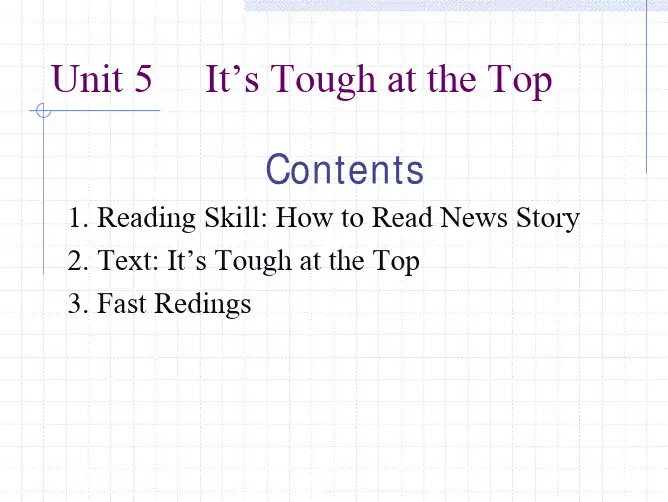
《典范英语》(5a-L5)教学参考The Treasure Chest教学参考的目的在于为实验课提供一个基本的思路和框架,帮助实验教师更好地把握课题理念。
课题组鼓励实验教师结合学生的实际情况适当做出调整,将实验课上出特色。
一、教学目标1. 语言能力目标:学生能够听懂录音;能够绘声绘色地独立朗读故事;能够理解故事情节;能够根据图片和关键词复述故事或独立讲述故事主要情节;能够发挥想象力改编故事。
2. 非语言能力目标:通过改编故事,培养学生的想象力和表达能力;通过表演培养学生的团队合作精神;培养学生大胆表达自己想法的自信和勇气。
二、课时安排每周不少于两课时,1-2个课时完成一个故事。
要求学生课前反复听录音跟读。
三、教师要求1. 教师课前须熟读故事,了解故事内容。
2. 对于较难的单词,教师可板书,并配合动作和表情帮助学生理解。
3. 全英文授课。
四、教学用具多媒体设备、CD机、课件(课题组提供)、故事图片(见情节分析环节)。
五、课堂教学基本步骤1. 导入(Lead-in):讨论水上运动,引入故事情境(1)展示几幅水上运动图片(见课件),与学生互动:What water sports do you know?What do you like to do?(2)展示故事第一幅图,自然过渡到看图讲故事环节:Look! Where did Mrs May take the children to? What did the children do? Let’s find it out in the story.2. 看图讲故事(Storytelling):了解故事背景教师利用课件播放故事前6幅图片,并用丰富的表情、生动的英文和适当的肢体语言给学生绘声绘色地讲故事,引导学生观察图片,了解故事背景。
(Picture 1)Mrs May took some of the children to the swimming pool.(指向游泳池)The children were good swimmers and they liked going with Mrs May.(Picture 2)The children were taking a swimming test.“It’s time to begin,”said Mrs May. “Who wants to go first?”“We do,” said Nadim.(Picture 3)Biff, Chip, Wilma, and Nadim jumped into the pool. The water was warm.“Off you go,” called Mrs May.(Picture 4)They had to swim up and down the pool. (动作演示up and down)They had to swim ten lengths. (动作演示two lengths)Wilma was first to swim ten lengths. Biff and Nadim werenext.Was it easy for Chip to swim the ten lengths?No. It was hard for Chip to swim the ten lengths.“Come on, Chip,” called Mrs May. “Don’t stop. This isthe last length.”So Chip went on and everyone was pleased.(Picture 5)The swimming test was not over. What did they do next?Next they had to swim to the bottom of the pool.They had to pick up a brick and swim with it to the top.(Picture 6)All the children passed the swimming test.Was Mrs May pleased?Yes. “Well done, everyone,” she said. The children werepleased too.Were Mum and Dad pleased with Biff and Chip?What did Mum and Dad have for them?What did they do the next day?3. 朗读故事(Reading Dramatically):学会绘声绘色地朗读故事,朗读与理解相结合承接讲故事环节,引导学生绘声绘色地朗读故事,并能理解故事主要情节。
可编辑修改精选全文完整版《典范英语》(2b-L15)教学参考The Mud Bath教学参考的目的在于为实验课提供一个基本的思路和框架,帮助实验教师更好地把握课题理念。
课题组鼓励实验教师结合学生的实际情况适当做出调整,将实验课上出特色。
一、教学目标1. 语言能力目标:学生能够理解故事情节;听懂故事录音;惟妙惟肖地模仿录音;绘声绘色地独立朗读故事;认读ran with the ball, Kick it! fell over, bathroom, ran a bath, forgot等单词和词组;能看图复述主要故事情节。
2. 非语言能力目标:通过让学生观察图片预测故事情节培养学生的观察力和想象力;引导学生树立做事情要专心的意识;培养学生敢读、敢表达的自信和勇气。
二、课时安排要求每周不少于两课时,每课时至少完成一个故事。
三、教师要求1. 教师课前须熟读故事,了解故事内容。
2. 对于较难的单词,教师可板书,并配合动作表情帮助学生理解。
3. 全英文授课。
四、教学用具多媒体设备、CD机、课件(课题组提供)故事图片、句卡(见检查理解环节)。
五、课堂教学基本步骤1. 导入(Lead-in):借助题目、图片和问题猜测故事内容,引入故事情境教师展示故事题目和图片,通过问题引导学生猜测故事内容。
Who is this? (指向爸爸)What is Dad doing?Look at the title. What is a mud bath?Did Dad fall over in the mud? Did Dad have a mud bath after the footballgame? Let’s have a look.2. 看图讲故事(Storytelling):理解故事情节,观察为什么故事的名字叫The Mud Bath教师利用课件逐幅播放故事图片,并用丰富的表情、生动的英文和适当的肢体语言给学生绘声绘色地讲故事,引导学生观察为什么爸爸洗了一次泥浴。